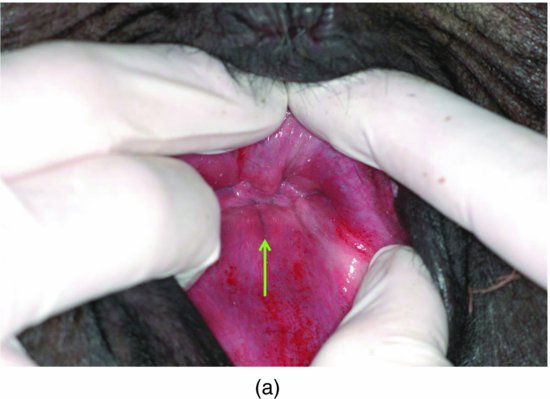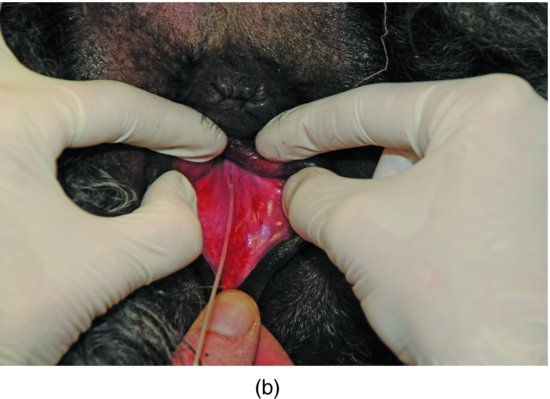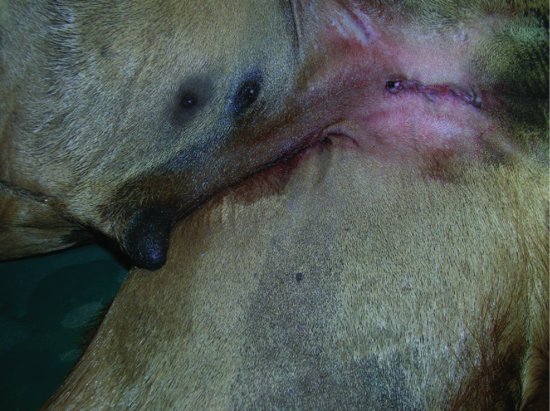Figure 48.4 Location of the external urethral orifice in a female alpaca (3a). A polypropylene catheter is placed into the urethra (3b).


URINARY TRACT EVALUATION
Animals with urinary tract disease will often present with an owner complaint of gastrointestinal or reproductive tract disease (e.g., straining, abdominal distension), making early identification of these signs at the time of initial consultation imperative to obtain prompt care by a veterinarian. A thorough health and husbandry history is useful in the management of all cases presented for veterinary care. For animals with signs referable to the urinary tract, owners should be questioned regarding dietary history, duration and progression of clinical signs, treatments administered, response to therapy, and the quality of the last observed urination. For females, pregnancy status, parturition history, and history of dystocia may provide diagnostic direction.
Evaluation should begin with a thorough, systematic physical examination, with the presence of signs of systemic illness, including apparent depression, dehydration, fever, abdominal distension, and first-compartment hypomotility noted and used to localize urinary tract disease. It is common for camelids to delay urination during transport and examination, but the animal should be observed for urination behaviors, with classification of these as normal micturition, dysuria, pollakiuria, or polyuria as well as observation for urine scalding.
Abdominal viscera are not readily palpable in camelids, but ballottement and succussion can provide characterization of the abdominal contents. In males, the urethra can be indirectly observed as it exits the pelvis and traces the body wall to the external urethral orifice. Nonproductive pulsations and generalized or focal swellings along this length are suggestive of obstruction, urethral rupture, hematoma, or abscess formation. The vulvar and preputial hairs should be examined for the presence of grit, blood, purulent matter, or urine.
The penis should be exteriorized and the prepuce and free portion of the penis examined. The penis is adhered to the prepuce in prepubertal males, making exteriorization of the penis for examination or catheterization difficult. This can be rarely accomplished in nonsedated animals, usually requiring at least some sedation with or without lumbosacral epidural anesthesia. The use of xylazine should be avoided in animals with potential obstruction due to its diuretic effects and induction of glucosuria.
Urinalysis should be performed in any animal with suspected urinary tract disease or any other systemic disease for which the disease or treatment may impact urinary health (Table 48.1). Free-catch urine may be obtained spontaneously during housing or physical examination. Animals that do not voluntarily provide a urine sample and have a patent urinary tract may be catheterized or have cystocentesis performed.
Table 48.1 Urinalysis reference ranges for llamas at sea level (Adapted from Fowler, 1998).
| Color | Clear, light yellow-amber | |
| Specific Gravity | 1.013–1.048 (mean 1.023) | |
| pH | 7–8.5 | |
| Protein | Negative | Some 1+ |
| Glucose | Negative | Some 1–3+ |
| Ketones | Negative | Some 1+ |
| Urobilinogen | Negative | Some 2–3+ |
| Bilirubin | Negative | |
| Blood | Negative | |
| Sediments | Calcium Oxalate common | |
| Uric Acid rare | ||
Values for fractional excretion and electrolytes in urine in llamas fed hay-based diets have been published (Lackey, et al. 1995).
Based on results of historical, physical examination and urinalysis findings, complete blood count with fibrinogen determination, serum biochemistry, ultrasound exam, abdominocentesis, excretory urogram, urinary endoscopy, or renal biopsy may be indicated to guide case management.
RECOMMENDED READING
Anderson DE, Constable PD, Yvorchuk KE, et al. 1994. Hyperlipidemia and ketonuria in an alpaca and a llama. J Vet Intern Med; 8(3):207–211.
Cardwell JM, Thorne MH. 1999. Hydronephrosis and ureteral duplication in a young alpaca. Vet Red; 145(4):104–107.
Dart AJ, Dart CM, Hodgson DR. 1997. Surgical management of a ruptured urinary bladder secondary to a urethral obstruction in an alpaca. Aust Vet J; 75(11):793–795.
DeWitt SF, Bedenice D, Mazan MR. 2004. Hemolysis and Heinz body formation associated with ingestion of red maple leaves in two alpacas. J Am Vet Med Assoc; 225(4):578–583.
Fowler ME. 1998. Medicine and Surgery of South American Camelids, 2nd ed. Ames: Blackwell.
Gerros TC. 1998. Recognizing and treating urolithiasis in llamas. Vet Med; 93(6):583–590.
Gerspach C, Hull BL, Rings DM et al. 2008. Hematuria and transitional cell papilloma of the renal pelvis treated via unilateral nephrectomy in an alpaca. J Am Vet Med Assoc; 232(8):1206–1209.
Kingston JK, Staempfli HR. 1995. Silica urolithiasis in a male llama. Can Vet J; 181:1411.
Lackey MN, Belknap EB, Salman MD, et al. 1995. Urinary indices in llamas fed different diets. Am J Vet Res; 56(7):859–865.
McClanahan SL, Malone ED, Anderson KL. 2005. Bladder outlet obstruction in a 6-month-old alpaca secondary to pelvic displacement of the urinary bladder. Can Vet J; 46:247–249.
McLaughlin BG, Evans NC. 1989. Urethral obstruction in a male llama. J Am Vet Med Assoc; 195(11):1601–1602.
Miesner MD. 2009. The straining camelid: GI or urinary? In: Proceedings of the 81st Western Veterinary Conference 2009. Available at: http://wvc.omnibooksonline.com/data/papers/2009_V559.pdf
Peauroi JR, Mohr, FC, Fisher DJ, et al. 1995. Anemia, hematuria, and multicentric urinary neoplasia in a llama (Lama glama) exposed to bracken fern. J Zoo Wildl Med; 26(2):315–320.
Poulson KP, Gerard MP, Spaulding KA, et al. 2006. Bilateral renal agenesis in an alpaca cria. Can Vet J; 47(2):159–161.
Stay updated, free articles. Join our Telegram channel

Full access? Get Clinical Tree



